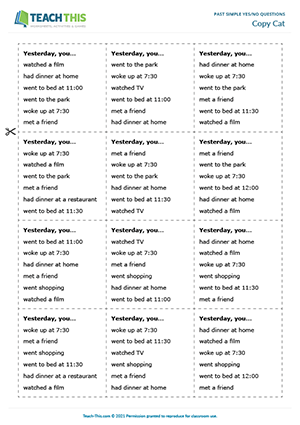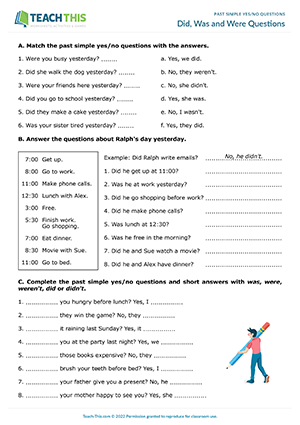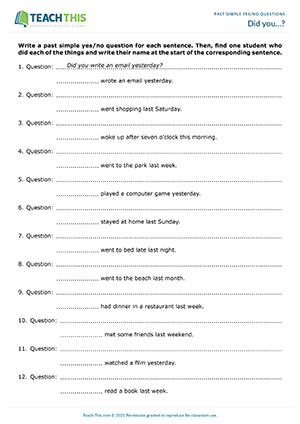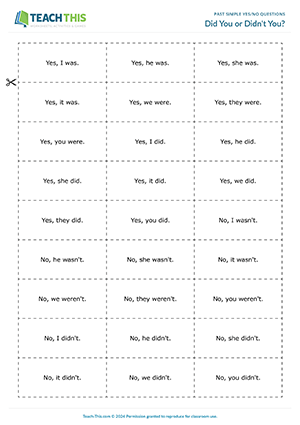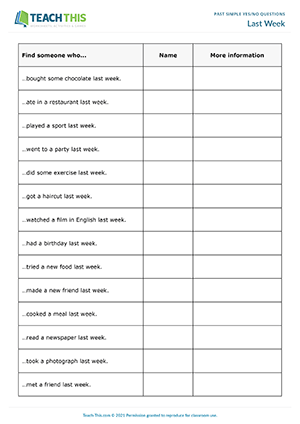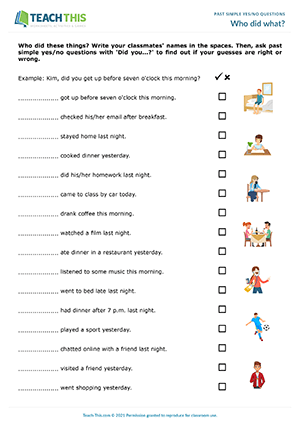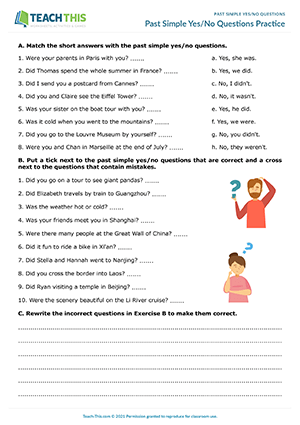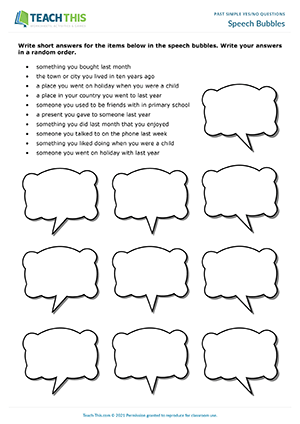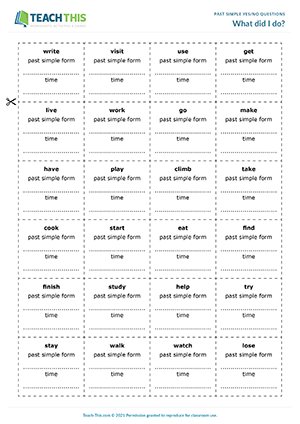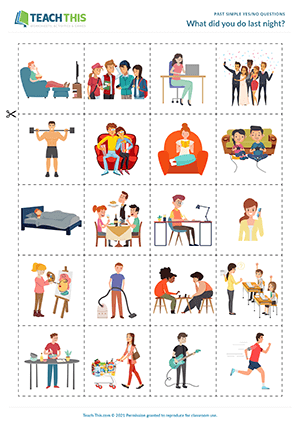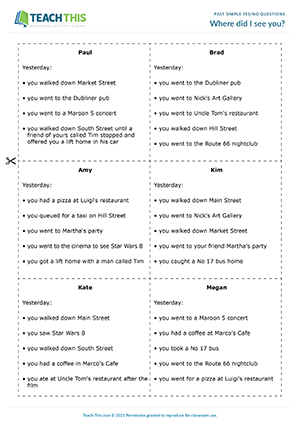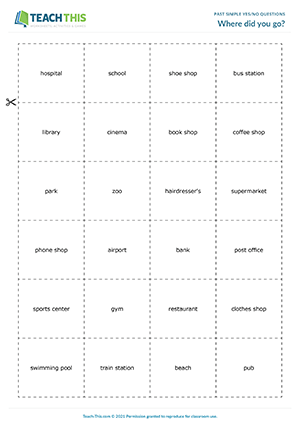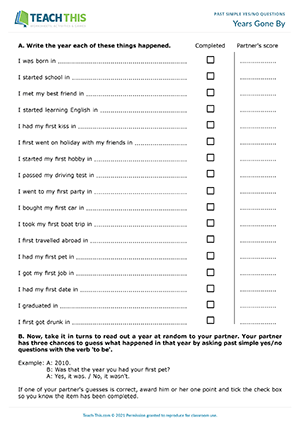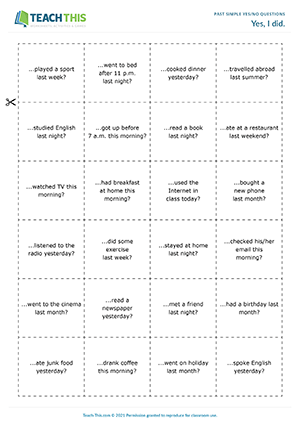In this engaging Did you questions activity, students find someone who did the same things as them yesterday by asking past simple yes/no questions with Did you...? First, students read sentences on a card that shows what they did yesterday. The students' task is to find someone who did exactly the same as them. All six activities must be the same for a match. Students do this by walking around the class asking past simple yes/no questions with Did you...? For example, 'Did you go to the park yesterday?' When a student finds someone who did the same as them, they write the person's name on the card and sit down with their matching partner. When a pair of students sits down, check their cards to make sure they are the same.
In this useful past simple yes/no questions worksheet, students practice simple yes-or-no questions and short answers with did and the verb to be. To start, students match past simple yes/no questions with answers. Next, students answer yes/no questions about someone's day yesterday. After that, students complete past simple yes/no questions and short answers with was, were, weren't, did or didn't. Students then move on to write yes/no questions that match answers. Next, students unscramble words to form past simple yes/no questions. Finally, students write their own past simple yes/no questions and ask them to a partner.
In this free questions with did activity, students write, ask and answer Did you...? questions. First, students write down a Did you...? for each sentence on their worksheet. Students then find one person who did each of the things shown on the worksheet and write their name at the start of the corresponding sentence by going around the class, asking each other the questions. When a classmate answers 'Yes, I did', the student writes down the classmate's name at the start of the sentence. The student then asks their classmate at least one past simple follow-up question before moving on to speak to someone else. Finally, students share their findings with the class.
This imaginative past simple yes/no questions game helps students practice yes/no questions and short answers with the verb to be and do. In groups, players take turns choosing one of their short answer cards without showing it to anyone, e.g. 'Yes, we were.' The player then thinks of a past simple yes/no question that will elicit the answer on the card, e.g. 'Were we in English class yesterday?' The player then asks the question to another student in the group. If the student gives the same short answer that is on the card, the player wins and discards the card. If not, the player keeps the card. The first player to get rid of all their cards wins the game.
In this enjoyable past simple Find Someone Who activity, students ask and answer yes/no questions in the past simple about what they did last week. Students begin by going through the items on the worksheet and preparing the past simple yes/no questions they need to do the activity, e.g. 'Did you buy some chocolate last week?' Students then go around the classroom asking the questions to their classmates. When a student finds someone who answers 'Yes, I did', they write the person's name down on their worksheet and ask a past simple follow-up question, e.g. 'What kind of chocolate did you buy?' When everyone has finished, students give feedback to the class on what they found out.
In this past simple yes/no questions speaking activity, students make guesses about things their classmates did recently. Students then find out if their guesses are right or wrong by asking past simple yes/no questions with Did you...? Students start by guessing which of their classmates did the things on the worksheet. Students then complete sentences on their worksheet by writing the names of their classmates in the spaces, e.g. 'Kim got up before seven o’clock this morning.' Next, students find out if their guesses are right or wrong by walking around the class asking questions to the people they wrote on their worksheet, e.g. 'Kim, did you get up before seven o’clock this morning?' If a classmate responds ‘Yes, I did’, the student puts a tick in the box next to the sentence. If a classmate replies ‘No, I didn’t’, the student puts a cross. The student with the most correct guesses is the winner.
In this holiday-themed past simple yes/no questions worksheet, students practice questions and short answers with did, was and were. Students start by matching past simple yes/no questions with short answers. Next, students identify mistakes in past simple yes/no questions and rewrite them. After that, students complete past simple yes/no questions with words from a box. In the last exercise, students change statements into past simple yes/no questions.
In this intriguing past simple yes/no questions activity, students ask Did you...? questions to a partner in order to find out why they wrote certain answers. First, students write short answers for the items on their worksheet in a random order in speech bubbles. Next, students swap worksheets with a partner. Students then take turns asking past simple yes/no questions with Did you...? in order to find out why their partner has written the words in the speech bubbles. For example, if a student sees the word 'laptop' written in one of the bubbles, the student might ask 'Did you buy a laptop last month?' 'Did you give someone a laptop as a present last year?' Etc. When their partner replies 'Yes, I did', the student puts a tick next to the bubble. The student then asks past simple follow-up questions to find out more information and generate discussion. At the end of the activity, students report back to the class on the most interesting things they found out about their partner.
In this fun past simple yes/no questions game, students use Did you...? questions to find out what people did at different times in the past. First, students look at verbs on cards and write the past simple form underneath each verb. Students then think of a time in the past when they did the actions and write the time expression on each card, e.g. yesterday. Students then take turns turning over a card from their pile and showing it to the other students. The other students then race to guess what the student did by asking past simple yes/no questions using the verb and time written on the card, e.g. 'Did you write an email yesterday?' The first student to ask the right question wins and keeps the card. The student with the most cards at the end wins.
In this free past simple yes/no questions game, students guess what their classmates did last night by asking questions with Did you...? Students take turns picking up a picture card that shows what the student did last night. The other students then race to guess what the student did by asking them past simple yes/no questions with Did you...? For example, 'Did you watch TV last night?' 'Did you hang out with friends last night?' Etc. The student replies accordingly with 'Yes, I did' or 'No, I didn't'. The first student to ask the right question wins and keeps the card. The student with the most cards at the end of the game wins.
In this entertaining past simple yes/no questions game, students ask and answer Did you...? questions in order to find out where they saw other people yesterday. At some point yesterday, each student saw the other members of their group. The aim of the game is for each student to work out where they saw the other group members. To do this, students use information on a card that shows what they did yesterday. Students ask past simple yes/no questions to each other until they find a place that they both have in common, e.g. 'Did you go to Luigi’s restaurant yesterday?' Students respond with 'Yes, I did' or 'No, I didn't', according to the information on their card. When a student finds a place they have in common with another student, they write the other person’s name next to the place on their card. The first group to work out where everyone saw everyone else wins the game.
In this past simple yes/no questions guessing game, students ask a classmate Did you...? questions in order to find out where they went. One student from Team A starts by taking a card. The card shows where the student went. Team B then tries to find out where the student went by asking them past simple yes/no questions with Did you...? For example, 'Did you watch a movie?' Etc. If the student replies 'Yes, I did', Team B says the name of the place they think the student went or asks another past simple yes/no question for confirmation. If Team B guesses correctly, they win and keep the card. Team B can ask a maximum of ten questions per card. If they don't find out where the student went after ten questions, Team A keeps the card. Then, a student from Team B takes a card, and it's Team A's turn to ask the questions, and so on. The team with the most cards at the end of the game wins.
Here is a creative past simple guessing game to help older students practice past simple yes/no questions with the verb to be and saying years. First, students complete sentences about life events by adding in the year that each thing happened to them. Next, in pairs, students take turns reading out a year at random from their worksheet. Their partner then has three chances to guess what happened in that year by asking past simple yes/no questions with the verb to be, e.g. 'Was that the year you had your first pet?' If their partner asks the right question, the student awards them one point and writes it in the corresponding column on the worksheet. The student with the most points at the end of the game wins.
In this amusing past simple true or false guessing game, students practice asking and answering past simple questions. A student from Team A picks up a card, makes a past simple yes/no question from the prompt on the card, and asks the question to one of the players in Team B, e.g. 'Did you play a sport last week?' The chosen player from Team B answers 'Yes, I did', regardless of whether it’s true or not. Team A then asks three past simple follow-up questions to the player. After the player has answered the three questions, Team A decides if the player’s answer is true or false. The player then reveals the truth. If Team A is correct, they score a point. The teams then swap roles. The team with the most points at the end of the game wins.
Latest Free
Resources
- The Bus Stop
Getting Around (B1)
Date Added: 1st of October
- Study Skills Showdown
Study Skills (B2)
Date Added: 10th of September
- Everyday Objects Bingo
Everyday Objects (A1-A2)
Date Added: 25th of August
- Action Verb Races
Actions (A1-A2)
Date Added: 18th of August
- Birthday Basics
Birthdays (A1-A2)
Date Added: 8th of August
Latest Member
Resources
- Casual Greetings
Greetings and Introductions (B2)
Date Added: 22nd of October
- Identifying and Clarifying Problems
Dealing with Problems (B2)
Date Added: 22nd of October
- What if we tried...?
Dealing with Problems (B2)
Date Added: 22nd of October
- Suitable Excuses
Making Excuses (B2)
Date Added: 21st of October
- Superlatives Showdown
Superlatives (A1-A2)
Date Added: 21st of October



